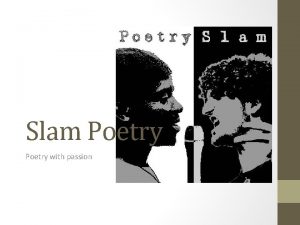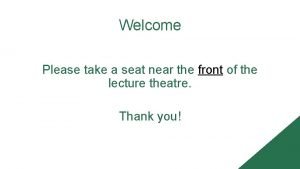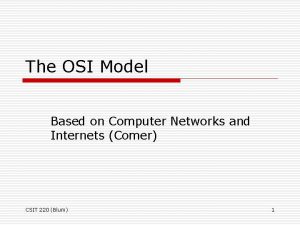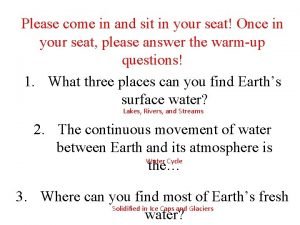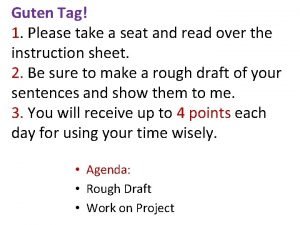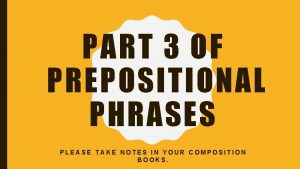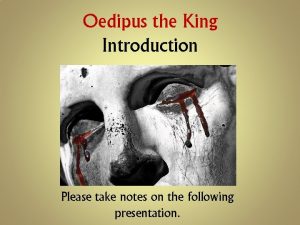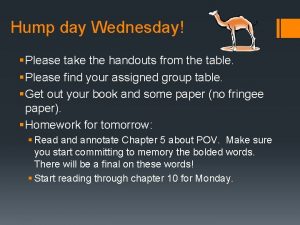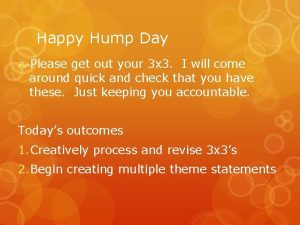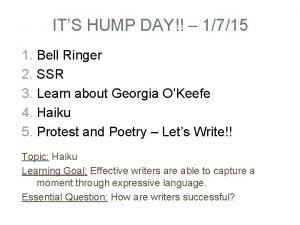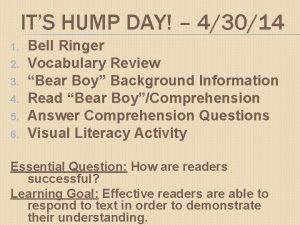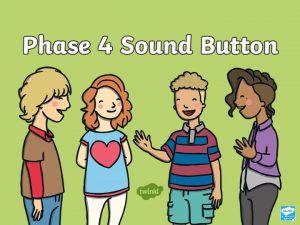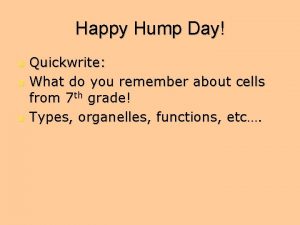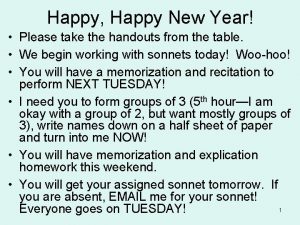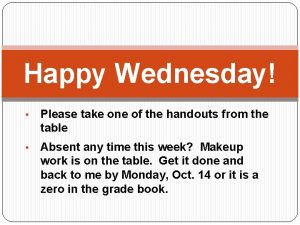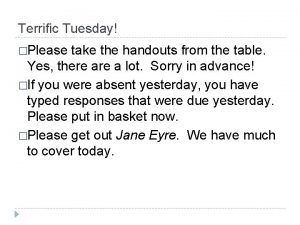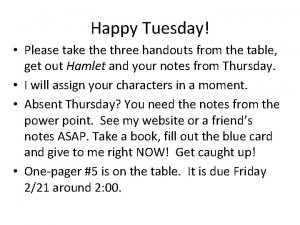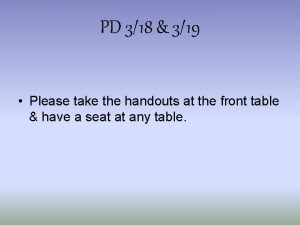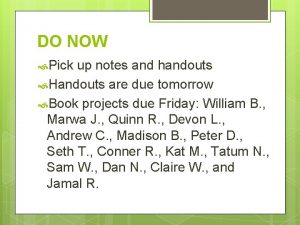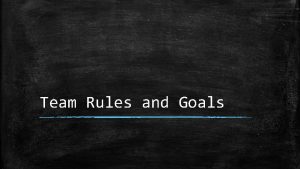Its Hump Day Please take all the handouts



















- Slides: 19

It’s Hump Day! �Please take all the handouts from the table. �Take 3 different highlighters from the box �You need out your Sound and Sense text �You need paper and something to write with. You will have homework tonight. �Deeply breath in, slowly exhale out.

Today’s Outcomes �Understand how to read and write about poetry �Practice TP-CASTT with a poem in class and write an analytical paragraph for tomorrow

Reading Poetry �Read the poem out loud and more than once. LISTEN to how it sounds and where the line breaks are. �Look up words you don’t know--always and forever. Especially if the poem is making use of ALLUSIONS! These are important and add meaning. The AP assumes you are well-read. Don’t prove them wrong.

As you read… (Look at Poetry Portfolio handout) �First…you are looking for patterns. As you approach the poem looking for ideas, remember these things. �The first time you see something; you should say, “That’s interesting. ” �The second time it appears, you should say, “That’s suspicious. ” �The third time you see it, DEAL WITH IT! It is probably worth writing about. �Why do these things keep happening again and again? This will help point you towards the THEME/MESSAGE poem.

� Next…consider what this poem is about. Instead of writing your analysis around the technique, let the big ideas of the poem guide your writing. The technique should be used to help analyze how the idea is developed throughout the poem. Think in terms of intention and effect. Ask yourself these questions: � Who is the speaker? Remember the author is NOT the speaker. The speaker is a persona the author has created. Who do you think it is? How do you know this? � What is the occasion of the piece? What do you think are the events that inspired this piece? What evidence supports your idea? � Who is the intended audience and how do you know? � What is the purpose of the piece? � This will help point you towards the THEME/MESSAGE poem.

� Finally, when you write your analysis, these are the questions you are ALWAYS answering. It might feel robotic at first, but you will quickly figure out your own writing style and adapt as you go. Consult rubric for more information. THIS IS THE BASIC PART OF YOUR ANALYSIS. THESE QUESTIONS ARE THE FOUNDATION OF YOUR ANALYSIS. � What is it? What ideas, devices, and/or interesting things do you see in the poem? Name the technique. Be specific. Give evidence from the poem to show this technique in use. � What does it do and how? What is the effect of this interesting idea or device in the poem? This is the beginning of your warrant. This is part of the so what? You can’t just name the technique. What is it doing? � Why is it relevant? So what? What is the intention or purpose of this idea or device in the poem? How does it help us understand the overall meaning of the poem (theme)? More warrant stuff. � Let’s look at sample paragraph. This is what you will write for tomorrow.

First, let’s discuss your homework �Sample paragraph on poem “Sound and Sense” �Thesis template…to help with thesis/claim construction �With your highlighters, create a legend at the bottom of the sample essay: ◦ One color for Topic Sentence/Claim ◦ One color for Evidence ◦ One color for Warrant

Your job tonight � Using the poem “We Real Cool” (see very last page in stapled packet), you will read, annotate, fill out a TP-CASTT chart AND write a one page paragraph. See Poetry Portfolio Handout and sample essay for details, but here it is: � Homework for Close Reading - Poetry: For your assigned chapter and after the student led lesson, we will assign you a poem, and you will write a WELL-CRAFTED paragraph or two in which you analyze the whole poem for the technique we covered in class. � Rough drafts must be DOUBLE-SPACED typed in a 12 point font. Please use an MLA heading and the technique you are writing about as the title. You will include a copy of the annotated poem with your short essay. Please see attached sample essay. Keep the essay to one page. You are free to adjust fonts and margins to a smaller size to make this happen. NOTHING BIGGER than 1” margins or 12 point font. � This rough draft will get feedback from me ONLY if you meet the deadline. I do not take late work. This is your redo. DO NOT ASK TO PRINT. COME PREPARED!

Let’s Practice �TP-CASTT “We Real Cool” �Write paragraph on poem due tomorrow. �Read rubric on back of Portfolio handout

Drill Day � 5 TH HOUR Fire Drill—leave my room and take a right, go down stairs and out MAIN ENTRANCE to parking lot, hustle back when done. �Lock Down---Stay in classroom � 6 TH Hour Tornado Drill---leave my room and take a right, go down the stairs and go to the library, hustle back when done. �I AM TAKING ATTENDANCE! DON’T GET LOST! DON’T ACT LIKE A FOOL! WE HAVE STUFF TO DO!

Day 2 ---Essay Reflection �Get out your “We Real Cool” Chart and paragraph Today’s Outcomes: • Review analytical paragraph expectations • Work to complete TP-CASTT and begin paragraph on group poem.

Claim/Topic Sentence �In Gwendolyn Brook’s poem “We Real Cool, ” her use of repetition creates a cool indifference that enhances the idea that following the crowd might not be so cool after all. �Things to notice: I used the template to create my claim. Author’s name and poem title are included. I didn’t list EVERY technique I could analyze, but just a big that keeps coming up again and again. I include the MESSAGE of the poem as well. Did you do this? Make yourself a note to follow the template for all your paragraphs.

Technique and Evidence (What is it? ) � One of the first ways that Brooks creates a cool indifference in the speaker is through her use of repeating the word “We” throughout the poem. For example, she writes in lines 1 and 2, “We real cool. We/Left school. We…” She makes use of “We” 8 times in this short poem. � Things to notice: I transition into the evidence by naming the technique I will analyze (repetition). I set up my evidence. I don’t just plop it into the paragraph. I also name the lines I am going to analyze. Notice how I punctuate lines of poetry with a slash. � Look at your evidence. Did you do this? Make a note of what you need to improve for your

Warrant: What does the technique do and how? Why is it important? (connect to theme) The repetition of “We” reinforces the idea that the speaker isn’t alone in his indifference against “the establishment. ” The “We” is repeated at the end of each line in the poem and creates an image of a gang of young individuals who have no regard for the law. The speaker and his crew skip school and participate in other illegal activities. However, there is a shift from cool indifference as a group, to a subtle focus on the consequences of following the crowd in the last line because there is no “We” at the end of the poem. It just ends with “die soon. ” While the repetition of “We” created a sense of unity when this group was breaking the rules, in the end there is no “We” because their disregard has negative effects in the end. The repetition helps show what happens when a person follows the crowd: [they] die soon. Look at your example. Does it answer the questions above? What are you missing? Your warrant must explain why the author is making these choices and how these choices create meaning (theme). Make note on what you need to improve.

In Gwendolyn Brook’s poem “We Real Cool, ” her use of repetition creates a cool indifference that enhances the idea that following the crowd might not be so cool after all. One of the first ways that Brooks creates a cool indifference in the speaker is through her use of repeating the word “We” throughout the poem. For example, she writes in lines 1 and 2, “We real cool. We/Left school. We…” She makes use of “We” 8 times in this short poem. The repetition of “We” reinforces the idea that the speaker isn’t alone in his indifference against “the establishment. ” The “We” is repeated at the end of each line in the poem and creates an image of a gang of young individuals who have no regard for the law. The speaker and his crew skip school and participate in other illegal activities. However, there is a shift from cool indifference as a group, to a subtle focus on the consequences of following the crowd in the last line because there is no “We” at the end of the poem. It just ends with “die soon. ” While the repetition of “We” created a sense of unity when this group was breaking the rules, in the end there is no “We” because their disregard has negative effects in the end. The repetition helps show what happens when a person follows the crowd: [they] die soon. Claim Evidence (What is it? )

Now your turn �Take your TP-CASTT Chart and group poem �Write a paragraph for this poem using everything you have learned so far. Complete fill in TP-CASTT Chart. �It is due Tuesday, Oct. 7.

A note about “chunking” your poem �When you read poetry, don’t read to the end of the line. Read to the end of the punctuation that ends the sentence. Look for , but �If ; : . ? ! , and , or there isn’t “traditional” punctuation being used, then look for commas, where are the pauses? �OR pay attention to line breaks. �Punctuation acts as “traffic” signs that tell you when you pause, stop or go on. You will understand a poem better if you PAY

Read your Poetry Portfolio Handout � Homework for Close Reading - Poetry: For your assigned chapter and after the student led lesson, we will assign you a poem, and you will write a WELL-CRAFTED paragraph or two in which you analyze the whole poem for the technique we covered in class. � Rough drafts must be DOUBLE-SPACED typed in a 12 point font. Please use an MLA heading and the technique you are writing about as the title. You will include a copy of the annotated poem with your short essay. Please see attached sample essay. Keep the essay to one page. You are free to adjust fonts and margins to a smaller size to make this happen. NOTHING BIGGER than 1” margins or 12 point font. � This rough draft will get feedback from me ONLY if you meet the deadline. I do not take late work. This is your redo. DO NOT ASK TO PRINT. COME PREPARED!

Summative Grades �Summative Grade 1: Presentation ◦ I will model a lesson for you tomorrow. Be here! �Summative Grade 2: Analytical Paragraph on your group poem---rough draft due Tuesday, Oct. 7 �Summative Grade 3: Portfolio of 4 analytical paragraphs. I will assign these separately throughout the presentations. Due dates for rough drafts will vary. Final portfolio will be due at end of month.
 Yet another day
Yet another day Day 1 day 2 day 3 day 4
Day 1 day 2 day 3 day 4 Track management system
Track management system Migration hump
Migration hump Nonspecific t wave abnormality
Nonspecific t wave abnormality Hampton hump sign คือ
Hampton hump sign คือ Rib hump scoliosis
Rib hump scoliosis My hat is old my teeth are gold
My hat is old my teeth are gold Day 1 day 2 day 817
Day 1 day 2 day 817 Please be quiet. i (try) to sleep
Please be quiet. i (try) to sleep I work all night i work all day
I work all night i work all day Poetrywithpassion
Poetrywithpassion Welcome please take a seat
Welcome please take a seat Please do not throw away sausage pizza
Please do not throw away sausage pizza Please come in and take a seat
Please come in and take a seat Please take a seat
Please take a seat Take prepositional phrase
Take prepositional phrase Please take out some time
Please take out some time Please take notes
Please take notes Zoo103 handouts pdf
Zoo103 handouts pdf











